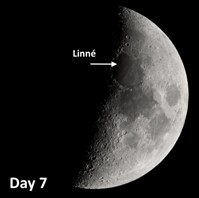The week of March 27-April 2 takes us from Day 29 to Day 6 This week we will highlight the moon crater Linné, located in the NE quadrant of the Field Map at G11 and viewable on Tuesday night.
 Linné: [NE/G11; L=12°E] Linné is a simple, relatively young moon crater with an interesting history. It is 1.5 miles in diameter (only about 1.3 arc-seconds at the average distance of the Moon), which makes it about twice the size of Meteor Crater in Arizona. Linné is surrounded by very light-colored material, and, because its appearance changes so much with different angles of illumination, this was once taken as evidence that the Moon was not a totally dead place. In 1866 it was erroneously reported that Linné had vanished. The idea caught on and was cited as proof that the Moon was still geologically active. Observe Linné under different lighting angles and see if you can convince yourself (if you didn’t know better) that Linné could disappear. Observe it over the next few days, then come back at full Moon and compare.
Linné: [NE/G11; L=12°E] Linné is a simple, relatively young moon crater with an interesting history. It is 1.5 miles in diameter (only about 1.3 arc-seconds at the average distance of the Moon), which makes it about twice the size of Meteor Crater in Arizona. Linné is surrounded by very light-colored material, and, because its appearance changes so much with different angles of illumination, this was once taken as evidence that the Moon was not a totally dead place. In 1866 it was erroneously reported that Linné had vanished. The idea caught on and was cited as proof that the Moon was still geologically active. Observe Linné under different lighting angles and see if you can convince yourself (if you didn’t know better) that Linné could disappear. Observe it over the next few days, then come back at full Moon and compare.
OF ADDITIONAL INTEREST IN SPACE
On Tuesday, Mars is 2° south of the Moon and Mercury is 1.5° north of Jupiter. On Friday, Venus is 1.3° north of Uranus (you’ll need a telescope to see Uranus).
======================
It is highly recommended that you get a copy of Sky and Telescope’s Field Map of the Moon, the very finest Moon map available for use at the telescope. It is available for $10.95 at www.skyandtelescope.com and on Amazon. All features mentioned in this blog will be keyed to the grid on the Field Map and will look like this: Plato: [NW/D9]
Credits:
Courtesy of Gray Photography of Corpus Christi, Texas
Lunar photos: NASA / USGS / BMDO / LROC / ASU / DLR / LOLA / Moon Globe. Used by permission
- Rupes Cauchy: A Best Known Fault on the Moon - July 22, 2024
- Moon Crater Schickard – Crater Floor has Stripes - July 15, 2024
- Moon Craters Langrenus and Vandelinus - July 8, 2024